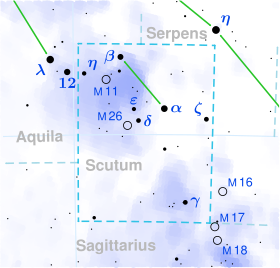R Scuti
| Observation data Epoch J2000 Equinox J2000 |
|
|---|---|
| Constellation | Scutum |
| Right ascension | 18h 47m 28.95s |
| Declination | −05° 42′ 18.5″ |
| Apparent magnitude (V) | 4.2—8.6 |
| Characteristics | |
| Spectral type | G0Iae-K2p(M3)Ibe |
| U−B color index | 1.53 |
| B−V color index | 1.47 |
| Variable type | RV Tau |
| Astrometry | |
| Radial velocity (Rv) | 43.80 km/s |
| Proper motion (μ) |
RA: -44.73 mas/yr Dec.: -32.78 mas/yr |
| Parallax (π) | 0.95 ± 0.43mas |
| Distance | 750pc |
| Absolute magnitude (MV) | ~ −2 - −3 |
| Details | |
| Mass | 0.55-0.68 M☉ |
| Radius | 70 R☉ |
| Luminosity | 9,400 ± 7,100 L☉ |
| Surface gravity (log g) | 0.0 cgs |
| Temperature | 4,500 K |
| Metallicity [Fe/H] | -0.4 dex |
| Other designations | |
| Database references | |
| SIMBAD | data |
R Scuti (R Sct) is a star in the constellation of Scutum. It is a yellow supergiant and is a pulsating variable known as an RV Tauri variable. It was discovered in 1795 by Edward Pigott at a time when only a few variable stars were known to exist.
R Sct is the brightest of the RV Tau-type stars and the American Association of Variable Star Observers (AAVSO) contains over 110,000 observations of this star. At its brightest it is visible to the naked eye, and at its dimmest can be located with good binoculars. In the sky it is about 1 degree northwest of the Wild Duck Cluster (Messier 11).
RV Tauri variables often have somewhat irregular light curves, both in amplitude and period, but R Scuti is extreme. It has one of the longest periods known for an RV Tau variable, and the light curve has a number of unusual features: occasional extreme minima; intermittent standstills with only small erratic variation that may last for years; and periods of chaotic brightness changes.
The spectrum of R Scuti is peculiar, especially at cooler temperatures near the minima. In deep minima, much of the spectrum corresponds to an early K supergiant, but the spectrum also develops TiO bands more typical of an M-class star.
The recognised spectral type of G0Iae-K2p(M3)Ibe gives an idea of the complexities of this star. Both the radius and temperature change, with maximum brightness corresponding to maximum temperature. The radius changes lag and the smallest size occurs about a quarter of the period after the minimum brightness.
The spectral luminosity type classes R Sct as a supergiant, a bright supergiant (class Ia) near maximum, but it is actually thought to be a highly evolved and expanded low mass star probably no more than 10,000 times the luminosity of the sun even at its brightest. The period-luminosity relation for type II Cepheids suggests a luminosity of 9300 L☉, similar to the spectrophotometric derivation at 9400 L☉. Other derivations have produced much lower values, but often making unrealistic assumptions about the distance based on an obsolete Hipparcos parallax value.
...
Wikipedia

